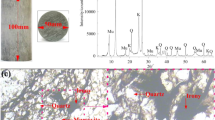Abstract
Compact tension specimens of annealed Ti-4 Al-3 Mo-l V were exposed under sustained load for periods of up to 8 days to determine the effects of initial stress intensity and test environment on subcritical crack growth. Crack growth occurred by a tunneling process with no surface crack extension until just prior to final rapid failure. Crack growth in vacuum or moist air environments occurred at stress intensities as low as 40 pct of the fracture toughness, and there was no evidence of a threshold stress intensity below which crack growth would not occur. Specimens tested in salt water behaved similarly at stress intensities of greater than about 60 pct of the fracture toughness, but showed crack arrest at lower stress intensities. At lower stress intensities, resistance to crack growth in a saltwater environment was superior to that in vacuum or moist air. Subcritical crack growth was readily identified on the fracture surface after exposure in all three environments through the presence of numerous cleavage-like facets. A critical strain concept, with crack growth occurring as a result of creep processes, can be used to explain the results.
Similar content being viewed by others
References
M. J. May and E. Smith,Introductory Paper on Stable Crack Growth, British Steel Corporation PMC Conference on Mechanics and Mechanism of Crack Growth, Churchill College, Cambridge, 4–6 April, 1973.
D. N. Williams:Met. Trans., 1973, vol. 4, p. 675.
G. Sandoz,Proceedings of Conference on Fundamental Aspects of Stress Corrosion, R. W. Staehleet al, ed., p. 689, NACE, Houston, Texas, 1969.
H. H. Johnson and A. M. Willner:App. Mater. Res., 1965, vol. 4, p. 34.
D. P. Dautovich and S. Floreen:Met. Trans., 1973, vol. 4, p. 2627.
J. P. Landes and R. P. Wei:Trans ASME, J. Eng. Mater. Tech., 1973, vol. 95 (Series H), p. 2.
Standard Method of Test for Plane Strain Fracture Toughness of Metallic Materials, (ASTM Designation E339-72),ASTMStandards, Part 31, ASTM, Philadelphia, Pa., 1972, p. 955.
D. N. Williams, Battelle, Columbus Laboratories, Columbus, Ohio, unpublished research, 1973.
H. H. Johnson and P. C. Paris:Eng. Fract. Mech., 1968, vol. 1, p. 3.
D. A. Meyn and G. Sandoz:Trans. AME, 1969, vol. 245, p. 1253.
R. J. H. Wanhill:Corrosion, 1973, vol. 29, p. 435.
R. E. Curtis, R. R. Bayer, and J. C. Williams:Trans. ASM, 1969, vol. 62, p. 457.
H. P. Chu:Eng. Fract. Mech., 1972, vol. 4, p. 107.
D. A. Meyn, NRL Memorandum Report 2461, Naval Research Laboratories, June, 1972.
G. R. Yoder, C. A. Griffis, and T. W. Crooker, NRL Report 7596, Naval Research Laboratories, Aug. 24,1973.
Author information
Authors and Affiliations
Rights and permissions
About this article
Cite this article
Williams, D.N. Subcritical crack growth under sustained load. Metall Trans 5, 2351–2358 (1974). https://doi.org/10.1007/BF02644016
Received:
Published:
Issue Date:
DOI: https://doi.org/10.1007/BF02644016




